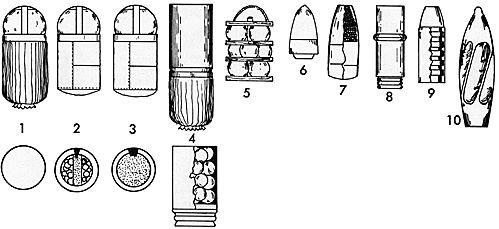1) Fixed charge with solid shot. Solid shot was most effective against massed bodies of troops, and fortifications.
2) Spherical case or shrapnel shell. Used by the British as a secret weapon in the Napoleonic wars, its use was considerably more widespread during the Civil War. Its fuse was set so that the shell would burst directly above the target showering it with musket balls. Although highly effective at times, it proved useless against quickly moving bodies of troops because the range had to remain constant for the artillerymen to zero-in on their target.
3) Shell designed primarily to penetrate an obstacle and then explode. It was considered less effective than shot or spherical case.
4) Canister. A can filled with 24 musket balls designed for close-range work only. When pressed by the enemy, defending batteries would load double and even triple charges of canister. A highly effechve measure at times.
5) Grapeshot. About twelve large iron balls separated by wooden sabots. This ammuninon could also be quite effective at greater ranges than canister. Yet the limited number of balls severely limited its use at ranges over 300 yards.
6) Three-inch rifle solid shot had a higher penetration than the twelve-pounder's round ball.
7) Percussion shell. The three-inch shell was inferior to the twelve-pounder because the explosive charge was smaller, and fuses often defective.
8) Three-inch canister. Smaller than the twelve-pounder, and therefore less effective with a narrower dispersal pattern.
9) Percussion shell for an Armstrong breech-loading field piece. Although the Armstrong delivered its shell with greater accuracy and range, its very small shell size limited its effectiveness even more than the three-inchers.
10) Shot for Whitworth breech-loading field piece. The Whitworth only fired a solid bolt as pictured. Although it made quite a racket, it was very ineffective.

More ACW Rifle-Musket
-
ACW: Introduction
ACW: Infantry
ACW: Infantry Tactics (Examples)
ACW: Cavalry
ACW: Artillery
ACW: Engineers
ACW: Entrenchments
ACW: Grand Tactics
ACW: Tactics: Auerstadt 1806 vs. New Market 1864
ACW: Conclusion and Bibliography
Back to Conflict Number 7 Table of Contents
Back to Conflict List of Issues
Back to MagWeb Master Magazine List
© Copyright 1974 by Dana Lombardy
This article appears in MagWeb (Magazine Web) on the Internet World Wide Web.
Other military history articles and gaming articles are available at http://www.magweb.com